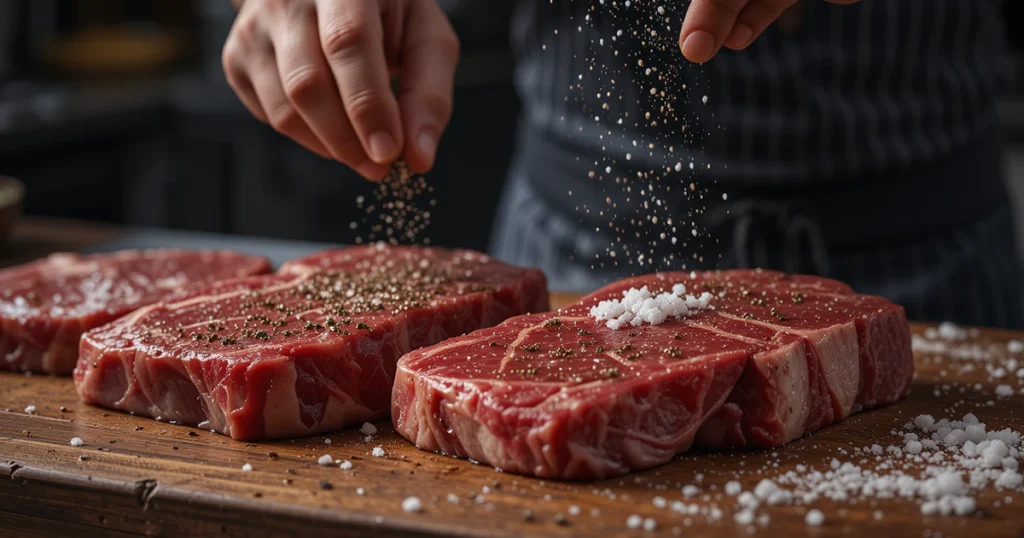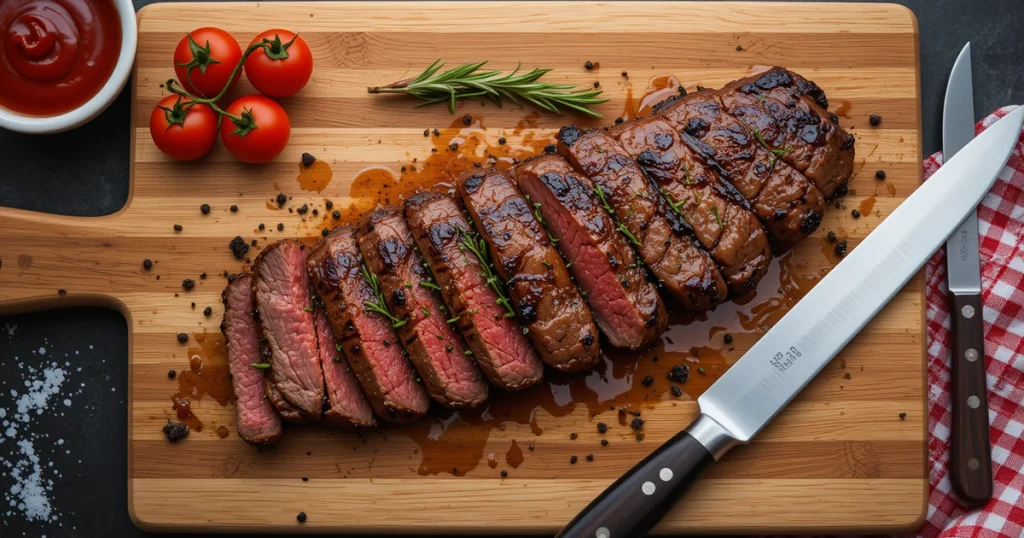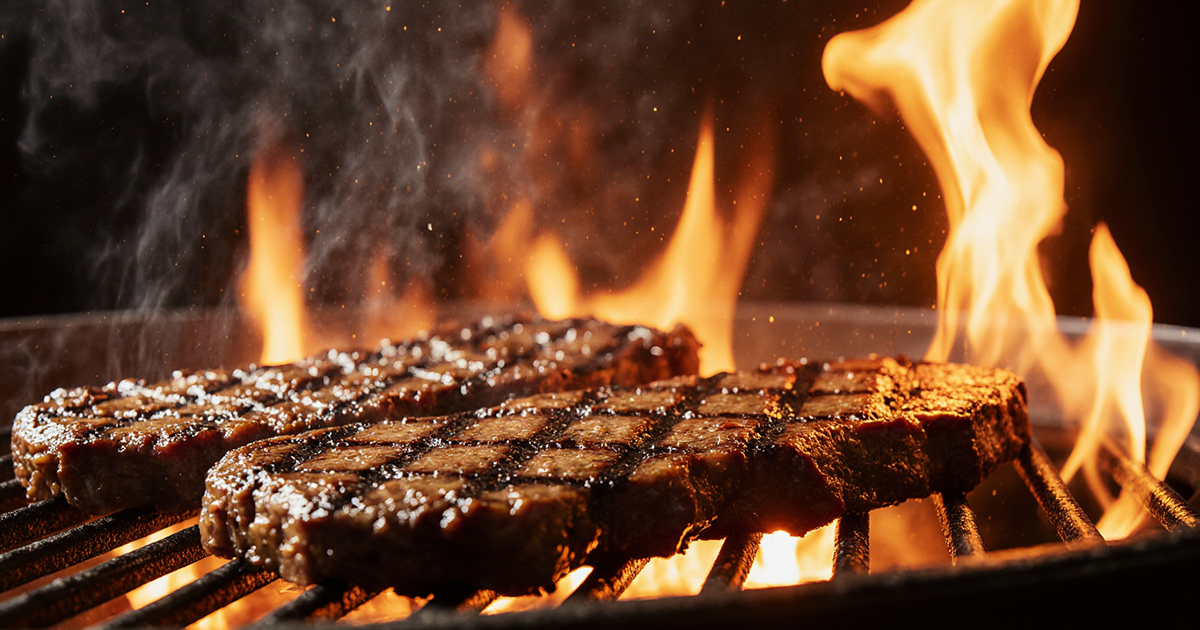Table of Contents
Grilling the perfect beef tenderloin is an art. It creates a gourmet masterpiece out of an excellent cut of meat. Your journey to a restaurant-quality grilled beef fillet starts here. We’ll share techniques for a mouthwatering result every time.
Cooking a grilled beef tenderloin needs precision and knowledge. It’s perfect for throwing a great dinner party or dazzling guests. Mastering this technique will boost your cooking skills and add gourmet flavors to your meals.
In this guide, you’ll learn from selecting the right cut to achieving perfect doneness. We’ll cover each step to prepare a beef tenderloin that’s juicy, tender, and full of flavor. Get ready to learn the secrets of grilling this premium cut like a pro.
From choosing the right meat to mastering grilling temperatures, you’ll become confident. You’ll create a grilled beef tenderloin that rivals any high-end steakhouse. Let’s examine the craft of preparing a remarkable supper.
Understanding Beef Tenderloin: Selection and Preparation
Choosing the right steak for your barbecue starts with knowing about beef tenderloin. The cut you pick can change the taste, texture, and grilling fun.
Choosing the Right Cut and Grade
When picking beef tenderloin for your barbecue, look for these important signs:
- USDA Prime: A premium grade with a lot of marbling
- USDA Choice: Good quality with some marbling
- USDA Select: Leaner cut with less fat
Select beef with minimal deterioration and a vibrant red color. Avoid cuts with too much moisture or dark spots.
Proper Trimming and Tying Techniques
Getting your steak ready right can make it a barbecue winner. Using a sharp knife, cut off the stiff outer layer of silver skin. Next, remove excess fat, leaving a thin layer for flavor.
The tenderloin cooks more evenly if it is wrapped in twine. Use twine every 1-2 inches to keep the meat’s shape while grilling.
Optimal Size and Weight Considerations
Choose your beef tenderloin based on how many you’re serving:
- 2-3 people: 1-2 pound roast
- 4-6 people: 3-4 pound roast
- 6-8 people: 4-5 pound roast
Remember, a well-chosen and prepared tenderloin can make your barbecue amazing.
Essential Tools and Equipment for Perfect Grilled Beef Tenderloin
Grilling starts with the right tools. Your beef tenderloin needs top-quality equipment for perfect cooking and flavor. Investing in professional-grade tools will make a big difference.
Here are the key tools you’ll need:
- High-quality meat thermometer for precise temperature monitoring
- Sturdy stainless steel tongs with long handles
- Heavy-duty grill grates
- Reliable heat-resistant cutting board
- Sharp boning knife for preparation
It is up to the individual to decide between gas and charcoal barbecues. Charcoal grills add a smoky flavor, while gas grills provide steady heat. Make sure your grill can keep temperatures between 400-450°F for the best beef tenderloin.
Don’t forget these extra accessories:
- Silicone basting brush for marinating
- Aluminum drip trays
- Grill cleaning brush
- Heat-resistant gloves
Keep your grilling equipment in top shape. Clean the grill grates after each use. To prevent rust, inspect the regions around burners or charcoal and keep tools in a dry location.

Mastering the Marinade and Seasoning Process
To make your beef tenderloin truly special, start with the right marinade and seasoning. Meat cuts like beef tenderloin soak up flavors well. This turns your beef recipes into something amazing with a bit of prep.
Knowing how marinades and seasonings work with different meats is key. You want to boost the tenderloin’s natural taste without hiding its soft texture.
Classic Marinade Recipes
Marinades can make your beef tenderloin taste better and feel softer. Try these great mixes:
- Red Wine Herb Marinade: Combine olive oil, fresh rosemary, garlic, and red wine.
- Balsamic Garlic Marinade: Blend balsamic vinegar, crushed garlic, and fresh thyme
- Citrus Pepper Marinade: Mix mustard, black pepper, and orange juice.
Dry Rub Combinations
If you prefer a quick seasoning, dry rubs are the way to go. They pack a lot of flavor without needing to marinate for hours:
- Classic Steak Rub: Use kosher salt, black pepper, and garlic powder
- Smoky Southwest Rub: Combine brown sugar, chili powder, cumin, and paprika.
- Herb-Infused Rub: Add salt, oregano, thyme, and dry rosemary.
Timing and Temperature Guidelines
Seasoning right means paying attention to timing and temperature. Marinate beef tenderloin in the fridge for 2-4 hours. Use dry rubs 30-60 minutes before grilling to let flavors sink in. To ensure uniform heat, always allow meat to come to room temperature before cooking.
Grilled Beef Tenderloin Temperature and Timing Guide
Precision and knowledge of temperature control are necessary to get the ideal juicy steak. Your tenderloin roast deserves careful attention to ensure optimal doneness and flavor.
Cooking temperatures play a crucial role in transforming your beef tenderloin from raw to a mouthwatering masterpiece. A reliable meat thermometer becomes your best kitchen companion during this process.
- Internal temperature determines the meat’s doneness
- Different levels require specific temperature ranges
- Carryover cooking affects final meat temperature
Check out this comprehensive temperature guide for your tenderloin roast:
| Doneness Level | Internal Temperature | Recommended Cooking Time |
| Rare | 125°F | 20-25 minutes |
| Medium Rare | 135°F | 25-30 minutes |
| Medium | 145°F | 30-35 minutes |
| Medium Well | 150°F | 35-40 minutes |
Pro tip: Remove your juicy steak from heat 5 degrees below your target temperature. The meat continues cooking during resting, which helps distribute internal heat evenly.
Remember, every cut of tenderloin roast is unique. Factors like thickness and grill temperature can impact cooking duration.
Expert Tips for Achieving Restaurant-Quality Results
Learning to grill beef tenderloin is more than basic cooking. Professional chefs share secrets to make it a top-notch meal.
Perfecting Resting and Slicing Techniques
Resting your grilled beef tenderloin is key to keeping it juicy. Allow it to rest for ten to fifteen minutes after grilling. Each slice becomes tender and delicious as a result of this procedure, which helps the liquids spread evenly.
Slicing right can enhance your dish:
- For precise cuts, use a sharp carving knife.
- Slice against the grain for maximum tenderness
- Cut approximately 1/2-inch thick slices
Avoiding Common Grilling Mistakes
Stay away from these common mistakes when grilling beef loin tenderloin:
- Never pierce the meat while cooking
- Avoid excessive flipping
- Always preheat the grill
- Use a meat thermometer for precise doneness
Serving Suggestions and Pairings
Enhance your grilled beef tenderloin with the right sides. Try pairing it with:
- Roasted garlic mashed potatoes
- Grilled asparagus
- Red wine reduction sauce
Follow these expert tips to make a beef tenderloin that will wow your guests.
Conclusion
Grilling beef loin tenderloin steak needs skill, patience, and detail. This guide shows how to make a great meal. It’s all about understanding each step.
Your success with beef tenderloin comes from choosing good meat and grilling it right. Every step, from picking the cut to controlling the temperature, is important. With practice, you’ll get better and more confident.
Try to make restaurant-quality beef at home. Invite friends and family to enjoy your cooking. Don’t be shy to try new marinades and seasonings. Each time you grill, you’ll get closer to perfection.
Great cooking mixes science and passion. Your hard work will make your grilling impressive. So, go ahead and grill with confidence!

FAQ
Which beef tenderloin cut is ideal for grilling?
Choose a USDA Prime or Choice grade beef tenderloin. It should have marbling and even thickness. The center-cut is the most tender and cooks evenly.
Look for a well-trimmed tenderloin with a uniform shape. This ensures even grilling.
How long should I marinate beef tenderloin before grilling?
For optimal taste, marinate for 2 to 4 hours. Don’t marinate more than 8 hours to avoid mushy meat. Salt-based marinades should be limited to prevent too much salt.
What internal temperature should beef tenderloin reach for different levels of doneness?
Here are the internal temperatures for different doneness levels:
- Rare: 125°F (52°C)
- Medium-Rare: 135°F (57°C)
- Medium: 145°F (63°C)
- Medium-Well: 150°F (66°C)
- Well-Done: 160°F (71°C)
Take the meat off the grill 5°F before your target temperature. As it rests, it will continue to cook a little.
How long should the beef tenderloin sit after grilling?
Let it rest for 10-15 minutes before slicing. This makes the meat tender and juicy. To keep it warm, loosely wrap it in foil.
Can I grill a frozen beef tenderloin?
No, it’s best to thaw the meat before grilling. Thawing ensures even cooking and prevents bacterial growth. Allow 24 hours of thawing time for every 4-5 pounds of meat.
What are the best seasonings for beef tenderloin?
Use kosher salt, black pepper, garlic powder, and herbs like rosemary and thyme. For a richer flavor, try a dry rub with paprika, cumin, and brown sugar. Enhancing the natural flavor of the beef is the aim.
How do I prevent beef tenderloin from drying out on the grill?
To keep it moist, marinate or lightly oil the meat. Grill at 400-450°F. Use indirect grilling and don’t overcook. Let it rest after grilling. These steps help keep the meat tender and moist.
